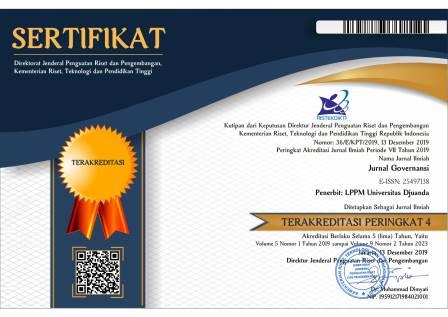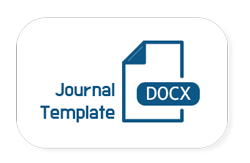Author Guidelines
Carefully read the submission guidelines as follows:
A. GENERAL INFORMATION
- Manuscripts must be original, have not been published previously in any scientific journal, that manuscripts are not being submitted for publication elsewhere, and will not be submitted to any media during the review process, unless the authors have officially withdrawn the manuscripts from Jurnal Governansi. Jurnal Governansi uses Similarity Check powered by Turnitin to prevent any suspected plagiarism in the manuscripts. Authors are expected to explicitly cite others' work and ideas, even if the work or ideas are not quoted verbatim or paraphrased. This standard applies whether the previous work is published, unpublished, or electronically available. Failure to properly cite the work of others may constitute plagiarism. Plagiarism in all its forms constitutes unethical publishing behaviour and is unacceptable. Jurnal Governansi applies a minimum standard of similarity score of the manuscript under 20%. If the manuscript performs above 20%, the article should be revised or rejected.
- The submitted manuscript is a research topic that does not conflict with social science and political science research.
- Manuscripts encompass a broad range of research topics in Public Administration: Development Administration, Regional Autonomy and Bureaucratic Reform, Apparatus Resource Management, Decentralization, Public Management, Public service, Public policy, Ethics and Governance
- The journal is published 2 (two) times a year, i.e. April, and Oktober.
B. STRUCTURE OF THE MANUSCRIPT
- Manuscripts are written in English and use standard scientific usage.
- Manuscripts should be prepared in Microsoft Word format, except for Graphs using Microsoft Excel program and Figures using JPEG or PDF format.
- Manuscripts should be typed using Cambria fonts at 12 points. Manuscripts should be typed single-spaced throughout the paper, including abstract, body of the document, references, appendixes, tables, and figures.
- Manuscripts are prepared in A4 paper, margins on all four sides are 2.54 cm. The body of paper must be elaborated between 6.500 - 7.000 words including abstract, and references
- Writing references should use a tool such as Mendeley, Zotero or EndNote for reference management and formatting, and choose APA 7th ed (https://owl.purdue.edu/owl/research_and_citation/apa_style/apa_formatting_and_style_guide/in_text_citations_the_basics.html
- It is essential that you follow every detail of the Jurnal Governansi template (2024). Please try to follow the template as closely as possible.
- The title of paper is max 10 words, 15 pt, bolded and centered without acronym or abbreviation. The Abstract (MAX 200-250 WORDS) should be informative and completely self-explanatory (no citation in abstract), provide a clear statement of the problem, the proposed approach or solution, and point out major findings and conclusions.
- Manuscripts content should be arranged as the following order: Title, Name of the author(s) and their institutions, Abstract, Introduction, Methods, Results and Discussion, Conclusion, Acknowledgment (if any), References.
- Introduction section: explain the context of the study and state the precise objective. An Introduction should contain the following three parts:
- Background: Authors have to make clear what the context is. Ideally, authors should give an idea of the state-of-the art of the field the report is about.
- The Problem: If there was no problem, there would be no reason for writing a manuscript, and definitely no reason for reading it. So, please tell readers why they should proceed reading. Experience shows that for this part a few lines are often sufficient.
- The Proposed Solution: Now and only now! - authors may outline the contribution of the manuscript. Here authors have to make sure readers point out what are the novel aspects of authors work. Authors should place the paper in proper context by citing relevant papers. - Method section: the presentation of the experimental methods should be clear and complete in every detail facilitating reproducibility by other scientists.
- Results and discussion section: The presentation of results should be simple and straightforward in style. This section report the most important findings, including results of statistical analyses as appropriate and comparisons to other research results. Results given in figures should not be repeated in tables. This is where the author(s) should explain in words what he/she/they discovered in the research. It should be clearly laid out and in a logical sequence. This section should be supported suitable references.
- Conclusion section: Summarize sentences the primary outcomes of the study in a paragraph. Are the claims in this section supported by the results, do they seem reasonable? Have the authors indicated how the results relate to expectations and to earlier research? Does the article support or contradict previous theories? Does the conclusion explain how the research has moved the body of scientific knowledge forward?
- We will usually expect a minimum of 30 references primarily to journal papers, depending on the length of the paper. Citations of textbooks should be used very rarely. All cited papers should be referenced within the text of the manuscript.
- Figures and Tables should be referenced in the text. Author also must explain what the reader should look for when using the table or figure. Focus only on the important point the reader should draw from them and leave the details for the reader to examine on her own.
- Figures:
All figures appearing in article must be numbered in the order that they appear in the text.
b. Each figure must have a caption fully explaining the content
c. Figure captions are presented as a paragraph starting with the figure number i.e. Figure 1, Figure 2, etc.
d. Figure captions appear below the figure
e. Each figure must be fully cited if taken from another article
f. all figures must be referred to in the body of the article
Tables:
a. Material that is tabular in nature must appear in a numbered captioned table.
b. All tables appearing in article must be numbered in the order that they appear in the text.
c. Each table must have a caption fully explaining the content with the table number i.e. Table 1, Table 2, etc.
d. Each column must have a clear and concise heading
e. Tables are to be presented with single horizontal line under: the table caption, the column headings and at the end of the table.
f. All tables must be referred to in the body of the article
g. Each table must be fully cited if taken from another article - Each citation should be written in the order of appearance in the text. Citations and references must sequential
Example of article structure :
Subdivision - numbered sections
Divide your article into clearly defined and numbered sections. Subsections should be numbered 1.1 (then 1.1.1, 1.1.2, ...), 1.2, etc. (the abstract is not included in section numbering). Use this numbering also for internal cross-referencing: do not just refer to 'the text'. Any subsection may be given a brief heading. Each heading should appear on its own separate line.
C. THE GUIDELINES FOR THE MANUSCRIPT BODY TEXT
The title of the manuscript: The title should be informative and be written both briefly and clearly. It cannot diverse multi interpretations. It has to be pinpoint with the issues that will be discussed. The beginning word is written in the capital case and symmetrically. The article title does not contain any uncommon abbreviation. The main ideas should be written first and followed then by its explanations. The article title should be written within sixteen words, 13pt-sized font, with the bold selection and in the center text format.
Abstract: This Abstract section should be typed in Cambria 12 pt while the number of words is around of 200-250. The single spacing should be used between lines in this article. The article is written in English, the abstract should be typed in English. The abstract should be typed as concise as possible and should be composed of: problem statement, method, scientific finding results, and short conclusion. The abstract should only be typed in one paragraph and one-column format. Keywords are min 4 words and max. 5 words using font Times New Roman 12 pt.
Introduction
The introduction should briefly place the study in a broad context and highlight why it is important. It should define the purpose of the work and its significance. The current state of the research field should be reviewed carefully and key publications cited. Please highlight controversial and diverging hypotheses when necessary. Finally, briefly mention the main aim of the work and highlight the principal conclusions. As far as possible, please keep the introduction comprehensible to scientists outside your particular field of research. References should be cited as (Robo (2014), (Skidmore, 2004; McConkey & Mariga, 2011; Rose & Howley, 2007), (Anders et al., 2011). See the end of the document for further details on references.
Methods
Methods should be described with sufficient details to allow others to replicate and build on published results. Please note that publication of your manuscript implicates that you must make all materials, data, computer code, and protocols associated with the publication available to readers. Please disclose at the submission stage any restrictions on the availability of materials or information. New methods and protocols should be described in detail while well-established methods can be briefly described and appropriately cited. Research manuscripts reporting large datasets that are deposited in a publicly available database should specify where the data have been deposited and provide the relevant accession numbers. If the accession numbers have not yet been obtained at the time of submission, please state that they will be provided during review. They must be provided prior to publication.
Results and Discussion
Result
Results section is provided prior to the discussion section. Each section stands alone as a subtitle. The findings and discussion should be written in not less than 60% of the entire body of the manuscript.
Discussion
The discussion section is intended to interpret the findings of the study in accordance with the theories used and not merely describe the founding. The discussion must be enriched by referring to the results of previous studies that have been published in scientific journals.
Conclusion
A conclusion is not merely a re-statement of the data or findings, but a synthesis of key points and, as mentioned in the “Introduction” which eventually produces the & quot; Results and Discussion & quot; chapter so that there is compatibility. In addition, the prospects for developing research results and the prospects for future research applications (based on results and discussion) can also be added.
Acknowledgment
This section displays authors appreciation to sponsors, fund donors, resource persons, or parties who have an important role in conducting research.
References
References of the manuscript must be up to date (in the last of 5 to 10 years and minimum). At minimum, there used 30 references that 40% of them are from primary sources/reputable academic journals) accessible by everyone. Authors are responsible for ensuring that the information in each reference is complete and accurate. All references should be cited within the text; otherwise, these references will be automatically removed. List of References shall be arranged in alphabetical order of last name of first-named author for with more than one author. Do not number them. Please refer and follow the APA Style 7th ed (https://owl.purdue.edu/owl/research_and_citation/apa_style/apa_formatting_and_style_guide/in_text_citations_the_basics.html
For some examples:
Muniruzzaman, M., Siddiky, M. R., Akter, S., & Haque, I. E. (2023). Premarital and Extramarital Relationships: A Study of A Selected Slum in Dhaka, Bangladesh. Indonesian Journal of Social Research (IJSR), 5(1), 1-22. https://doi.org/10.30997/ijsr.v5i1.277
Angela, C., & Yustina, A. I. (2023). The Negative Effect of Work Environment and Team & Co-Worker Toward Employee Burnout: Testing The Mediating Role of Engagement. Indonesian Journal of Social Research (IJSR), 5(1), 36-52. https://doi.org/10.30997/ijsr.v5i1.255
Joel Premkumar, J. P., M.S., S. B., & J, M. (2023). Does The Scheme “Free Bus Policy for Women in Public Transportation” Contributes to The Achievement of The Sustainable Development Goals?. Indonesian Journal of Social Research (IJSR), 5(1), 53-67. https://doi.org/10.30997/ijsr.v5i1.254


















